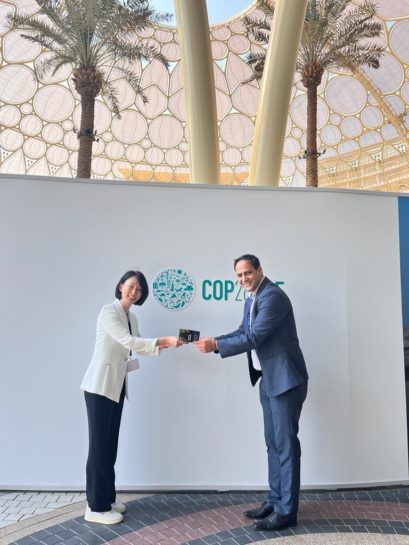OrCaSa sees fertile discussions for soil preservation at COP28
One of the highlights of COP28, held in Dubai from 30 November to 12 December 2023, was the agreement on accelerating efforts to phase out fossil fuels. However, another noteworthy achievement of this edition was the signature of the Declaration on Sustainable Agriculture, Resilient Food Systems, and Climate Action by a total of 158 nations committed to integrating food into their climate plans by 2025.
Bringing food systems into climate discussions means also considering soil protection and conservation issues. Dr. Jean-François Soussana, Vice-Chair for international affairs at INRAE, and Dr. Ahmad Al Bitar, CNRS scientist working at the Center for Spatial Studies of the BIOsphere (CESBIO), were in Dubai to represent the ORCaSa project at COP28.
‘The increase in soil carbon sequestration is recognised as a key means of enabling a net-zero carbon global balance, but efforts to implement regenerative agricultural practices that ensure the increase in soil organic carbon have been modest’, notes Dr. Al Bitar. ‘The subject was widely debated at COP28, and the ORCaSa project was invited to the Korea Pavilion by the Kyung Hee University (KHU) Applied Ecology Lab team to present its latest innovations’ (session: AgriCarbon-EO, a hybrid Monitoring, Reporting & Verification (MRV) approach that combines modeling, remote sensing, and assimilation).
In the framework of the ORCaSa project, he collaborates to raise awareness and develop scientific knowledge and methods on how to measure, report and verify soil carbon for croplands, thanks to a harmonised MRV framework. Indeed, increasing and monitoring soil carbon stocks are directly aligned with the Paris Agreement and the UN Sustainable Development Goals.
‘The increase in soil carbon sequestration is recognised as a key means of enabling a net-zero carbon global balance, but efforts to implement regenerative agricultural practices that ensure the increase in soil organic carbon have been modest.’
Today, there is a wide range of tools, parameters, data, and application contexts that enable MRV methods for soil carbon stock changes. In that way, and considering the diversity of soils (agricultural, forests, pastures, wetlands, public spaces in urban areas, etc.), an easy-to-use harmonised framework will greatly facilitate the day-to-day work of many experts in the environmental sector.
Korea is paving the way to urban soil carbon solutions
COPs are important networking moments, and the ORCaSa team did not miss the opportunity to share knowledge with their Korean peers on the topic of urban soil carbon. Indeed, the KHU Applied Ecology Lab is highly involved in carrying out the Korean Carbon Project (KCP), which aims to develop ‘a national greenhouse gases information system using a hybrid monitoring approach’. By tracking carbon uptake flows, the Korean teams are working on building detailed emissions and absorption maps to better understand and address the question of soil carbon dynamics in cities. As is the case for agricultural land, increasing soil organic carbon in urban areas can lead to increases in soil water retention, biodiversity and enhanced vegetation health, which can help to reduce the impact of ‘urban heat islands‘ during extreme heatwaves.
Thanks to the ORCaSa partners, with the recently established Soil Carbon International Research Consortium (IRC) and the Impact4Soil platform, which will be available in a few weeks’ time, sharing knowledge and scientific insights on soil carbon at global scale has renewed potential to advance new policies for climate change adaptation and mitigation.
